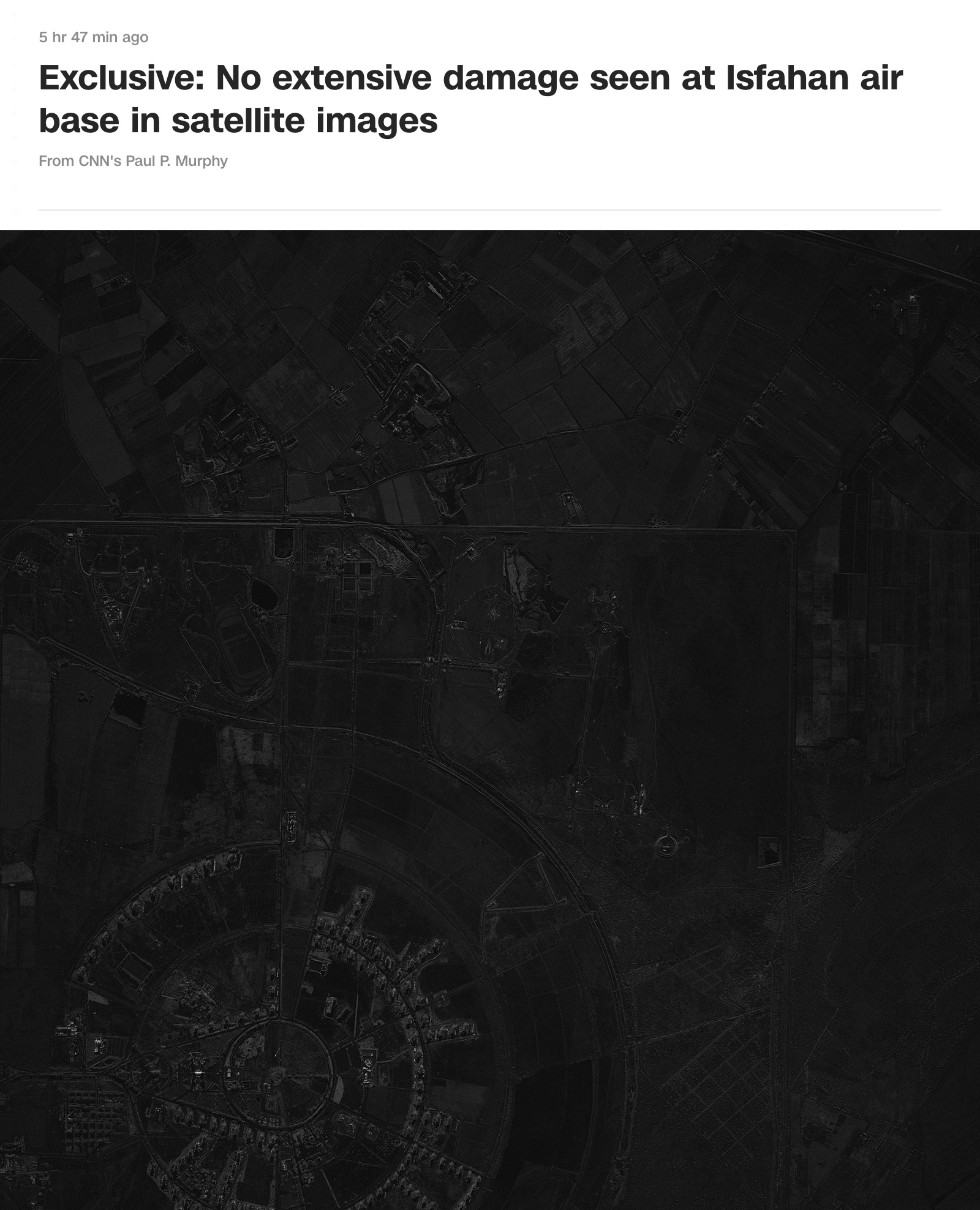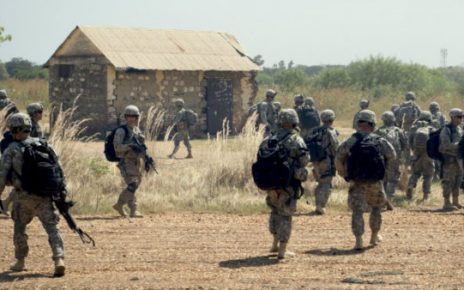Israel is said to have launched an attack in the vicinity of the Iranian city of Isfahan, according to US officials that spoke with Western corporate media. The attack, which Tehran has claimed was completely foiled, did not cause any known damage and seemingly represents a failure for Tel Aviv. Yet this event may not be over, and so far has only provided us with one confirmed insight — That the mainstream media is actively participating in launching psychological warfare efforts on Israel’s behalf.
Late this Thursday night [Friday morning in Iran], reports began to surface of explosions in Syria, Iraq, and Iran simultaneously. As social media began to ignite with a large series of unconfirmed videos and photos, in addition to claims of what may have just occurred, some thirty minutes passed before the situation became somewhat clear.
ABC News was the first media outlet to cite unnamed “US officials” who they say claimed that Israel had launched a missile attack in the vicinity of the Iranian city of Isfahan. Meanwhile, the Jerusalem Post was caught using photos of an airstrike in Gaza for an article about Israel’s alleged “missile strike”, while the same outlet continued to use already debunked photos of explosions in follow up articles it produced on the attack. ABC News also spread a graphic, in which it was depicted that Israeli strikes had been reported in 7 different locations across Iran. This was graphic was then spread across social media by various accounts, both pro and anti-Iranian, while many Israeli propagandists also helped in sharing the content and later deleted their posts.
Last night many large accounts reported that Israel had attacked Iran, yet Iranian media was reporting no explosions in the area. Today it seems clear that this was either a lie entirely or a failed attempt being lied about. #QuestionEverything https://t.co/k5PMtG7lIo https://t.co/HpG3BZ8vHX pic.twitter.com/n1lH6EzfEp
— The Last American Vagabond (@TLAVagabond) April 19, 2024
Western media reports claiming an Israeli missile attack on Iran had occurred, cited unnamed US officials and later Israeli officials, spread far and wide creating a sense of hysteria online. Yet inside of Iran the livestreams, eyewitness testimonies, and reports from Iranian media indicated that three large explosions had reportedly been heard near Isfahan and that the country’s air defenses had been triggered. Speaking to three separate contacts who live in and around Isfahan, I was informed by two that they heard the explosions and the other thought they heard something but wasn’t sure what it was until later. Eventually, a few hours later, the Iranian media began citing security sources that confirmed to them that there was an attack detected, but that the suspicious targets were a handful of small quad-copter drones and were quickly shot down by nearby air defense systems. According to the official Iranian government account of events, the sound of explosions were due to the air defense missiles that were shot, and they stated that no ground impacts were made by any of the drones.
We still do not have full confirmation of where these drones came from, with some Iranian media sources indicating that Israeli proxy groups inside of Iranian territory could have fired them, while others have speculated that the attack could have come from inside Iraq. However, the latter theory is more unlikely, as Isfahan is located in the center of Iran and the likelihood of a drone from Iraq reaching such depths inside the country is slim.
If we also look at the details revealed from satellite image analysis, published in western media, it is apparent that there was no indication of any missile or drone impacts at Iranian military facilities as claimed. The International Atomic Energy Agency (IAEA) also affirmed that no damage had been caused at nuclear facilities in Iran.
There were, however, confirmed missile strikes in southern Syria and inside Iraq. The Thalaa Airport in Syria’s southwestern province of Suwayda was damaged by Israeli airstrikes, as explosions were heard close to Bismayah, situated southeast of the Iraqi capital city of Baghdad. In addition to this, blasts reportedly impacted sites north of Iraq’s Central province of Babil. The extent of the damage from the strikes on Iraq is still not fully known, yet there have been reports indicating Israeli jets had struck a radar site affiliated with the Popular Mobilisation Units (PMU).
Although there do appear to have been Israeli missile attacks in Iraq and Syria, as unconfirmed videos from Iraq appear to feature sounds of fighter jets in the skies, there were no confirmed casualties and there has not been any evidence presented for a missile attack on Iranian territory. All that exists to provide a justification for reporting an Israeli missile attack are unnamed US and Israeli sources, so far.
Despite no actual damage or casualties being reported inside of Iran, precautionary measures were taken by the Iranian authorities, leading to the diversion of flights and closing of certain segments of Iran’s airspace. Another byproduct of the attack was an immediate rise in the price of oil, which interestingly eased shortly after Tehran began explaining that the attack was limited and had no real effect.
So What Actually Happened And Where Is This Going?
From what we can gather at The Last American Vagabond, the Israeli attack was extremely limited and can’t really be labelled as a direct attack, but rather amounted to an attempted strike at best. The drones clearly did not originate from Israeli territory, so it was either carried out using Mossad agents or a proxy group that operated under the orders of the Israelis. The full details are hard to properly ascertain at the moment, but it is clear that western and Israeli media are attempting to greatly exaggerate what truly happened.
There are two ways to read what just happened. 1) Israel has just worked with western media to concoct a false narrative that enables them to claim they launched an attack against Iran, while working to avoid further escalation. 2) Israel is preparing a larger attack and is attempting to drop Tehran’s guard so that they can mount a successful operation in the future.
EXCLUSIVE: “An Iranian military security official has revealed that the US contacted the Islamic Republic, asking the nation to allow Israel ‘a symbolic strike to save face’ following Iran’s retaliatory drone and missile barrage this weekend.” https://t.co/eKF7DO79C6
— Sharmine Narwani (@snarwani) April 16, 2024
If explanation 1 is true, then we can conclude from this that the Israelis were effectively deterred by Iran’s retaliatory strike last Saturday. This would explain the desperate attempt to try and make it appear like Tel Aviv conducted a successful missile attack against Iranian territory. It would also explain the logic behind launching airstrikes against Iraqi and Syrian territory, at the same time the failed drone attack was carried out on Iranian soil. This strategy, of feeding the media fake videos and photos of explosions, while producing the narrative of a powerful attack on three separate countries, may have been an attempt to bolster the image of the operation, as it may have been concluded that the attack inside Iran would have appeared too weak if conducted on its own.
Very grounded interview with Mairav Zonszein @MairavZ a Senior Israel Analyst @crisisgroup.
This row analysis provides a great insight into the Israeli current sentiment towards Netanyahu and his government and the mental issues that are affecting the supporters of the war… pic.twitter.com/2wf4giS5gV
— Freddie Ponton 🇫🇷 (@LFCNewsMedia) April 18, 2024
However, if explanation 2 is true, then this escalation is still an ongoing issue and there may still be a possibility of a wider regional war. In this case, there is little that can be concluded beyond speculation.
Assuming this scenario is over, we can conclude that Iran has just asserted itself as the top military power in West Asia. If the Israelis have truly backed down in such a humiliating fashion, it indicates that the Iranian retaliation for the attack on the consular segment of their embassy in Damascus, Syria, has effectively frightened Tel Aviv to the point where they are incapable of mounting any real attack on Iranian soil, for fear of the potential retaliation. If true, it appears unlikely that Iran will even see the need to retaliate against Israel, because its attack could be seen as purely an attempt to save face in front of its own public.
Iran could take this is another direction, however, capitalizing on Israel’s weakness at this point in time. As the US and Israeli governments discuss the possibility of invading Gaza’s southernmost city of Rafah, and an escalation with Lebanon appears inevitable, an Iranian retaliation against Israel could be an effective way of pressuring the Zionist regime into ending its war on Gaza. Tehran could hypothetically leverage its power in order to apply pressure on the United States to force the Israelis into concluding a ceasefire deal with Hamas in Gaza. A clash between Iran and Israel, which the Iranians initiate through arguing their right to self-defense and a response, would mean that Tel Aviv would be forced into entering a tit-for-tat battle with Islamic Republic.






